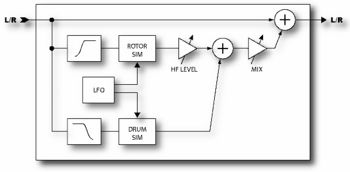Rotary cabinet
A Hammond B3 without a Leslie cabinet is like a BLT sandwich without the lettuce and tomato. Guitar players soon came to discover the wonderful tones of the Leslie cabinet and it's brethren. The classic Leslie cabinet is comprised of a spinning drum with a slot in it and a rotating horn called a rotor. A low frequency speaker is aimed into the spinning drum while high frequencies are sent to the horn. The result is unmistakable, from schmaltzy hockey-game to Steppenwolf, the Leslie cabinet became ubiquitous. Spinning drum alone versions have been produced by other manufacturers with Stevie Ray Vaughn's "Cold Shot" being one example of that sound.
The Axe-Fx Rotary Cabinet simulator reproduces all these classic sounds and offers more control. Also, it doesn't weigh 300 lbs and require four guys to move up a flight of stairs. Isn't technology great?
Parameters
- RATE - Controls the rate at which the "drum and rotor" spin. Connect this to a controller for real-time control.
- LDEPTH - Sets the modulation depth of the "drum". Higher settings provide a more pronounced throb.
- HDEPTH - Sets the modulation depth of the "rotor". To simulate a rotating drum only cabinet reduce this.
- HLEVEL - Sets the output level of the "rotor". Use this to balance the level between the drum and rotor.
- TEMPO - Locks the rate to the global tempo. For example, if the global tempo is 120 bpm and the tempo is set to a quarter note (1/4) then the LFO rate will be 2 Hz (120 bpm / 60 seconds = 2). To ignore the global tempo set the tempo control to NONE.
Leslie emulation
If you want to emulate a Leslie or Vibrotone using the Axe-Fx, there are three key components: slow speed, fast speed and the ramp between them. The latter is optional based on how authentic you want to be, but this is a guide at how to recreate the effect.
According to a page I found, the Leslie speeds are 40 and 390 RPM. Dividing by 60, that translates to .67 Hz and 6.5Hz, respectively. We'll use these values to set our rate modifier. The only decent way I know to translate values to modifier ranges is to carefully check the position of the knob at the START and END points you are interested in and then eyeball the modifier values.
Fortunately, the Axe-Fx makes setup easy:
- Hit ENTER on the RATE control to assign a modifier
- Choose the SOURCE expression pedal (or whatever you want to control it)
- Put the pedal in the initial, heel down position
- Page down until START is highlighted
- set a value (5.9% for the .67 Hz)
- hit EXIT
- check position of the knob
- hit ENTER and repeat sub-steps as needed
- Page down until END is highlighted
- set another value (64.6% for 6.5 Hz)
- hit EXIT
- check position of the knob
- hit ENTER and repeat sub-steps as needed
- Set MID somewhere in between (35% rough midpoint)
- Set DAMPING control to 1.000 second to simulate the Leslie's rise time
- Hit EXIT. You're done!
When complete, the effect should sound something like this. If you're very lazy, you can just download the patch used to record it.
If you want other cabinets' numbers, I found these:
- Leslie (16?): 40 - 390 RPM (.67 - 6.5 Hz)
- Measured on a Leslie 147:
- Top rotor: 48 - 400 RPM (.8 - 6.67 Hz)
- Lower drum: 40 - 342 RPM (.67 - 5.7 Hz)
- Measured on a Fender Vibrotone: 40 - 340 RPM (.67 - 5.67 Hz)
